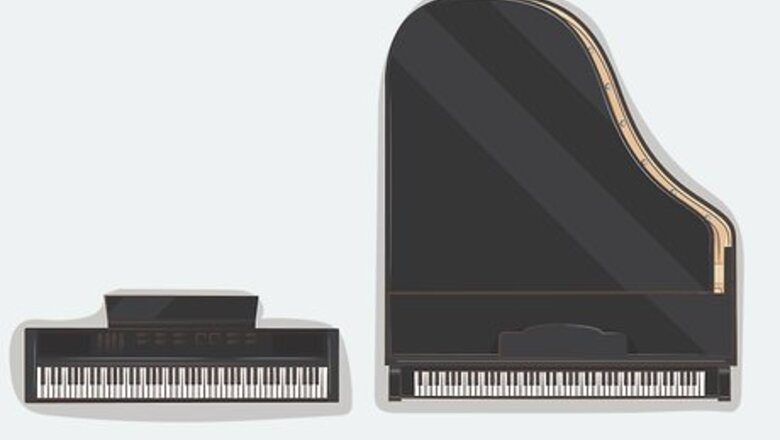
views
Instrument Set Up
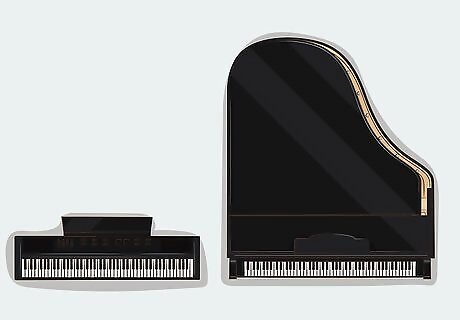
Choose a piano or keyboard. If you're dedicated to learning how to play the piano you need a piano or keyboard of your own that you can play at home. Otherwise, it will be difficult for you to maintain a consistent daily practice schedule. Acoustic pianos vary widely in style, size, and cost. A new piano suitable for a beginner typically will cost between $2,000 and $5,000 US. If that kind of expense is not in your budget, you might consider buying a used piano. An electronic keyboard is an acceptable substitute and may be your only option if you live in a dorm room or small apartment where an acoustic piano just won't fit. Look for one with a full-sized keyboard. They also typically have a headphone jack so you can play without disturbing roommates or neighbors. A beginner full-sized (88 keys) electric piano can run you somewhere around $300 to $400, whereas midrange beginner models are around $600 and up.Tip: If you get a keyboard, look for one with weighted keys. It will feel more similar to playing an acoustic piano.
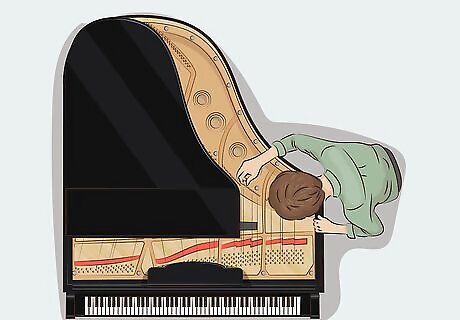
Get a used piano inspected before you buy it. Buying a used piano is a lot like buying a used car. Without an inspection, you can't be sure if you're getting a bargain or not. Some used pianos may have extensive damage that will end up costing you more to repair than if you went ahead and bought a new instrument. If you find a used piano that you're interested in, simply let the owner know that you want a professional to inspect the piano before you buy it. If they refuse to allow you to do this, don't buy the piano. They may be trying to hide a serious problem from you. Some music stores sell used pianos that have already been inspected by store staff. However, it's still a good idea to have an independent technician look over it before you buy it.
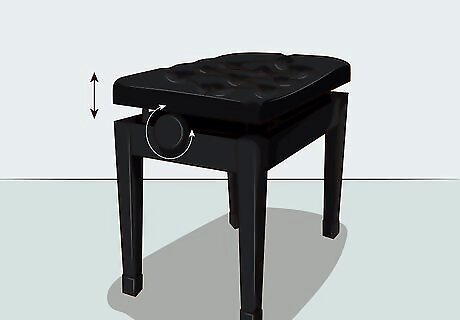
Invest in an adjustable bench if your piano doesn't come with one. With an adjustable bench, you will always be able to sit and play the piano with proper posture at the correct height. Using another chair as a substitute likely won't allow you to sit at the piano correctly. Stools are also available if you prefer a stool to a bench. Stools are more commonly used with electronic keyboards. If you bought an electronic keyboard instead of an acoustic piano, you might consider buying a stand for it so you can play it at the same height as you would an acoustic piano. Stands are also adjustable and typically can be folded up and stored out of the way when you're not playing, if space is at a premium.
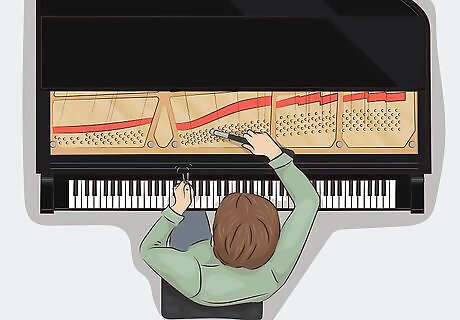
Have your acoustic piano tuned after you get it home. A piano should be tuned any time it is moved to a new location. If you purchased a new piano, this initial tuning may be included in your purchase price. If a tuning isn't included in your purchase, expect to pay around $100 US. Look for a Registered Piano Technician (RPT) in your area who has experience tuning pianos that are similar to yours in age and style. The Piano Technicians Guild has a global locator search available online that you can use to find an RPT in your area. You can also search for technicians that have experience in particular services, which may be helpful if you've bought a used piano that is damaged in some way and needs repair.
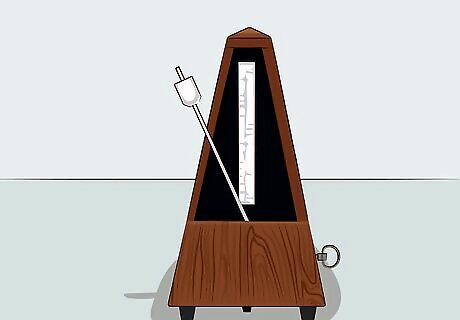
Buy a metronome so you can maintain consistent tempo. A metronome makes a ticking sound to keep you playing music at the same speed. You can find them online or at music stores. There are also smartphone apps you can download and use as a metronome. Many electronic keyboards come with a built-in metronome.
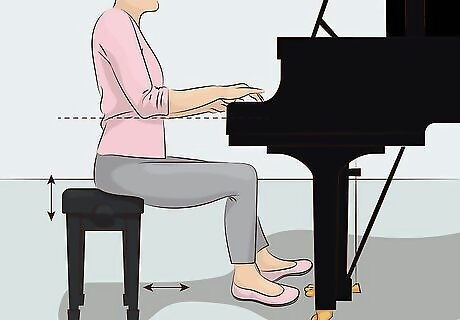
Adjust your bench so you can sit with correct posture. Set the bench in the center of the keyboard, at enough of a distance so you can sit on the edge of it. Raise or lower the bench until your elbows are roughly level with the keyboard when you place your fingers on the keys. Make sure your bench is close enough that you can place your fingers on the keys with your elbows bent. If you need to extend your arms to reach the keys, the bench is too far away from the piano. You should be able to sit with both of your feet flat on the floor and also reach the pedals when necessary (although you likely won't use the pedals when you're just starting out). If you can't reach the pedals without straining your legs, scoot the bench forward until you can. If your piano bench won't adjust high enough for you to sit with proper posture, use a pillow or cushion to sit up higher.
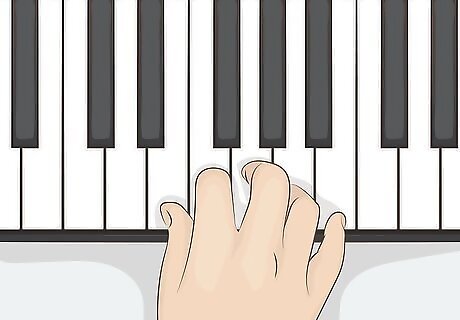
Practice correct finger placement on the keys. When you play the piano, cup your hands as though you're holding an egg and press the keys with the tips of your fingers – not the pads. Playing with flat fingers is an easy habit to get into, but it will make it difficult to play faster and more complicated music later on. Holding a small stress ball as you play can help guide your finger placement when you're just getting started. Make a habit of checking your finger placement regularly and adjusting as necessary until it becomes natural.
Mastering the Basics
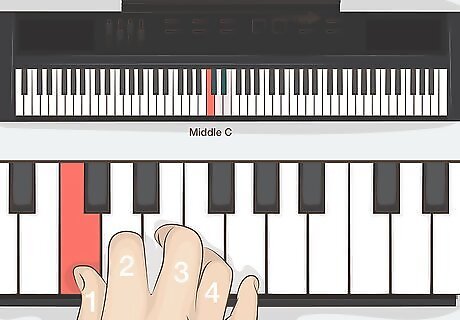
Find Middle C on the keyboard. As a beginner, Middle C serves as your anchoring point. It's the key in the very middle of the keyboard, the first white key in a set of 3 with 2 black keys in between. Place your right thumb on Middle C, then let the rest of your fingers fall on the white keys to the right of Middle C. Press the Middle C key with your thumb to play the note. In piano fingering notation, your thumb is frequently labeled with a 1. Then play the white key next to it, D, with your index or 2 finger. Your middle or 3 finger plays E, while your ring or 4 finger falls on the F key. Your pinky or 5 finger plays G. These are the first 5 notes of the C Major scale.
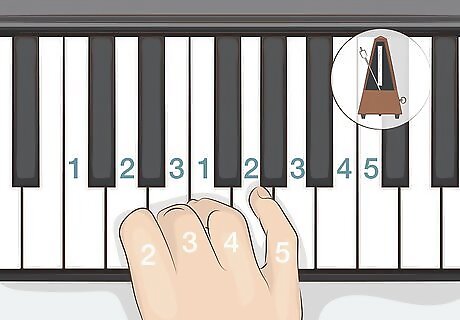
Set your metronome and practice the C Major scale. To play the full C Major scale, begin by playing the first 3 notes you played when you located Middle C: C, D, and E. Now, instead of playing F with your ring finger, tuck your thumb under your 3 fingers and slide your hand down to play F with your thumb. Your 4 fingers will now be in place to play the rest of the scale: G, A, B, and back to C an octave higher. Start with the metronome at a relatively slow tempo and practice the scale until you can play it smoothly, moving your hand through the notes and hitting them in order without making any mistakes or looking down at the keyboard. Then, speed the metronome up a little and try again. Two of the common ways of playing the scale is Similar motion and Contrary motion. To play in similar motion, put your hands at the lower half of the piano/keyboard, an octave apart from each other, and play in the same direction to the right, and when you reach an certain octave, play back to your starting point To play Contrary motion in C major, put both of your thumbs on the middle C and play the left hand going left and the right hand playing to the right and when you reach 1 or 2 octaves, play in reverse back the starting point. This exercise may seem boring, but if you master these fundamentals you'll find it much easier to play more complicated pieces later on. Scales help build muscle memory in your fingers and also give you greater spatial awareness, so you'll be able to find and play notes without looking down at the keyboard.
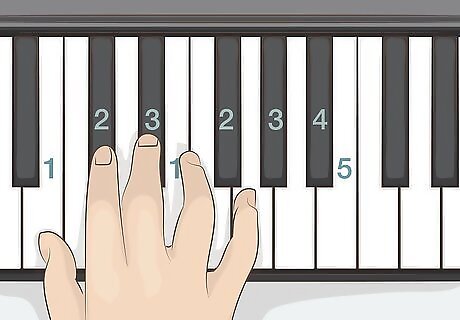
Try other scales to learn the relationship between the notes. Once you've mastered the C Major scale, you can move on to other scales. Some scales use only white keys, while others use white and black keys. As with the C Major scale, set your metronome to a slow tempo and gradually increase the speed. You can find scale diagrams online or use a smartphone app. Most scales make use of black keys as well as white keys, so practicing other scales will give you a greater familiarity with all the keys on the keyboard.Tip: Trying to find different scales on your own can be a fun exercise that helps you develop and train your ear.
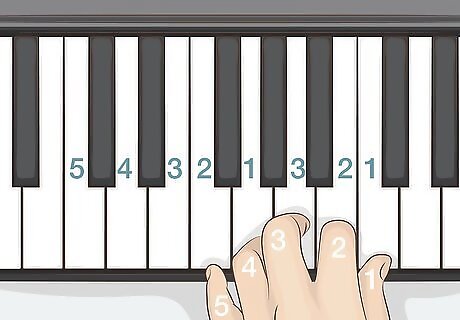
Practice scales with your left hand as well as your right. A scale played with your left hand uses the same notes as the scale played with your right hand, but everything is reversed. Essentially, when you play a scale with your left hand, your left hand is the mirror image of your right hand. As with your right hand, start with your metronome at a relatively slow tempo and gradually speed up. If you're right-hand dominant, expect the left hand to progress much more slowly than your right hand did. Just have patience and don't try to rush it.
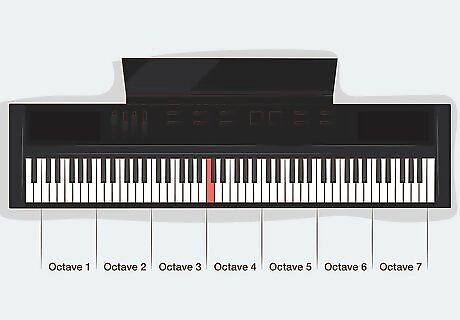
Identify octaves on your piano. You found your first octave when you played the C Major scale – the scale begins and ends on the same note, one octave apart. If you look at your keyboard, you'll notice that the same key arrangement pattern repeats. The same notes 12 notes repeat themselves from one end of the keyboard to the other: 7 white key notes (C, D, E, F, G, A, B) and 5 black key notes (C-sharp/D-flat, D-sharp/E-flat, F-sharp/G-Flat, G-sharp/A-flat, and A-sharp/B-flat). Notes in a different octave have the same pitch, they are simply higher or lower than each other. For example, you could continue playing the C Major scale from one end of the piano to the other, starting with the lowest C on the keyboard and ending on the highest C on the keyboard. You can do the same thing with any other scale.Tip: When you're just starting out, you may want to label the keys with the name of the note so you can remember it more easily. Once you get more familiar with the keyboard, you can remove your labels.
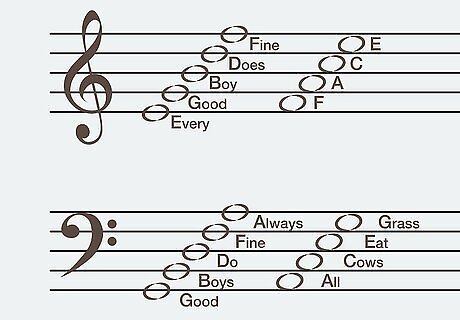
Pick up the basics of reading sheet music. You don't necessarily have to know how to read music to play the piano – some of the greatest pianists played by ear. However, learning how to read music gives you the ability to learn and play a lot more pieces more quickly. Music is notated on a staff with 5 lines and 4 spaces. Each line and space represents a note. If you see a note head on that line or space, you play the note represented. On the treble clef (notes played by your right hand) the 5 lines from bottom to top are E, G, B, D, and F. You can remember these with the mnemonic "Every Good Boy Does Fine." The 4 spaces from bottom to top are F, A, C, and E, which spell the word "FACE." The bass clef notates lower notes that you'll play with your left hand. The 5 lines from bottom to top are G, B, D, F, and A. You can remember these with the mnemonic "Good Boys Do Fine Always." The 4 spaces on the bass clef from bottom to top are A, C, E, and G. You can remember these with the mnemonic "All Cows Eat Grass."Tip: If the commonly used mnemonics don't work for you, try to make up your own. A unique mnemonic that you created may be easier to remember.
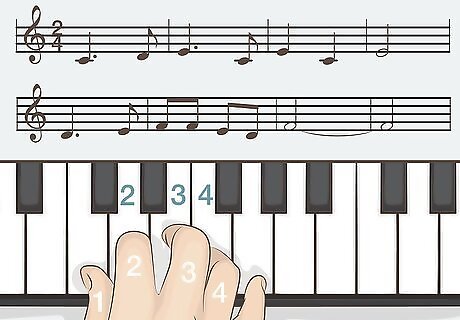
Try a basic melody with your right hand. Most beginning piano students start with simple folk melodies, such as "Twinkle Twinkle Little Star" or "Hot Cross Buns." However, there are plenty of other simple melodies that can be found in more popular, modern songs. For example, since you already know the C Major scale, try to pick out the "Do Re Mi" song from the movie "The Sound of Music." This song is actually designed to teach the C Major scale to the children in the movie, and the notes of the melody are fairly easy to find for yourself, even if you don't have a well-developed ear.
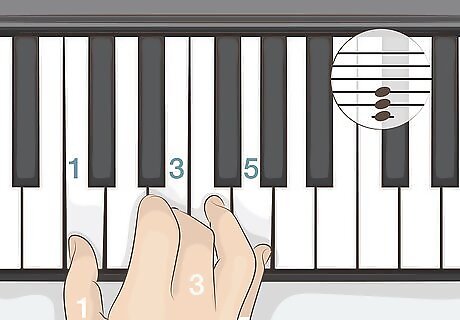
Add depth to your music with chords. A chord is 3 or more notes played together. Some of the most common chords are triads – chords with 3 notes. To form a major triad, you play every other note in the scale, starting with the first note of the scale. Since you're familiar with the C Major scale, try a C Major chord. Place your thumb on Middle C as though you were getting ready to play the scale. Your middle finger should be on the E key and your pinky finger on the G key. Press all three of those keys at the same time to play the C Major chord. There's a free online chord chart available at https://www.onlinepianist.com/piano-chords. You can also download one of the smartphone apps that has chord charts for piano. Most of these apps are free if you're okay with the app displaying ads occasionally (or you can pay a small amount to get the ad-free version).
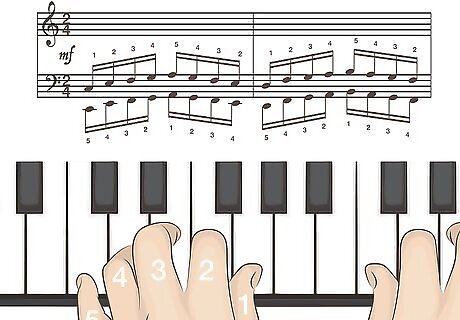
Try Hanon exercises to build strength and dexterity in your fingers. Hanon exercises have been used by piano teachers since the late 1800s to help students' fingers become stronger and more adept at playing the piano. You can download the exercises for free from https://www.hanon-online.com/. To get the most benefit out of the exercises, daily practice is recommended. Set aside 5 or 10 minutes of your total practice time just to do Hanon exercises.
Developing Your Skills
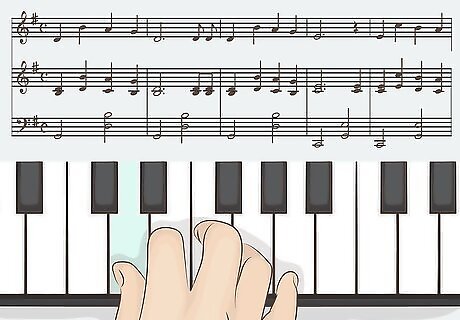
Learn some simple songs to increase your familiarity with the instrument. Once you're comfortable with the keyboard and can play scales without mistakes, you're ready to graduate to real music. You can play songs that are already relatively simple to play, or look for beginner arrangements of more complex songs. Try to find beginner sheet music that includes the name of the note inside the note symbol. This will help you start to read the music more easily. You can find sheet music like this in beginner's books and on some websites and smartphone apps. You can buy collections of sheet music arranged for different levels, either online or at your favorite music or book store. You can also download and print sheet music off the internet. Websites such as Musicnotes allow you to download sheet music and make it available on all of your devices. If you have a tablet, you can display your music on your tablet instead of printing it out (just make sure you turn off sleep mode). Keep in mind that because composition and arrangement copyrights are strictly controlled, you will seldom be able to download sheet music for free legally – particularly if you're looking for newer or more popular music.
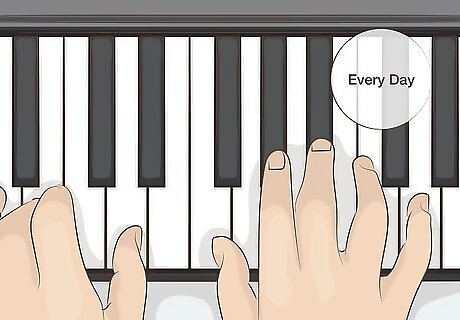
Make a habit of practicing every day. To get the most out of your training and progress more quickly, daily practice is essential. Young children may only be able to practice for 10 or 15 minutes a day. However, if you're an older student or an adult, try to practice at least 30 minutes a day. Professional musicians practice many hours everyday. If you can practice at the same time every day, eventually practicing piano will just become another thing you do every day, similar to brushing your teeth or taking a shower. At that point, you won't think about it in terms of whether you want to do it or feel like doing it – you'll just do it. EXPERT TIP Amy Nicole Levine Amy Nicole Levine Pianist, Music Teacher, and Songwriter Amy Nicole Levine is a Pianist, Music Teacher, and Songwriter, based in Oakland, CA. She performs in a wide variety of genres ranging from Jazz, Classical, Funk, R&B, Gospel, Rock, Reggae, Latin, Chorale, and others. Amy teaches private piano lessons to both adults and children at her studio in Oakland. Amy plays with multiple music groups throughout the Bay Area. She earned her Bachelor of Arts in Sociology from San Francisco State University. Amy Nicole Levine Amy Nicole Levine Pianist, Music Teacher, and Songwriter Quick piano progress happens with short, frequent practices rather than long, occasional sessions. Use the "chunking" method — focus on a small section at a time, repeating it until it's locked in. The "three times through" trick — successfully playing a part three times in a row — builds muscle memory. Regular repetition like this leads to steady improvement in piano skills.
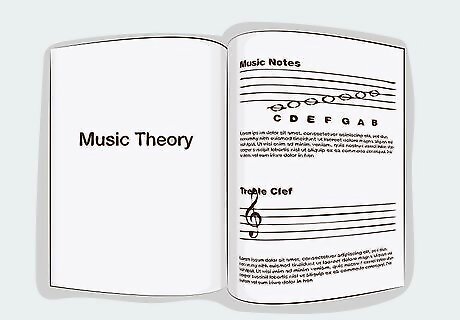
Use music theory books to learn to read music notation. Music theory books can help you advance your understanding of music as well as improve your ability to sight-read music notation. You can find these books online or at music stores. You may also be able to find websites with music theory exercises that can help improve your skills at reading music. If you check music theory books out of the library, complete the exercises in a separate notebook or make photocopies of the exercise pages – don't write in the book.
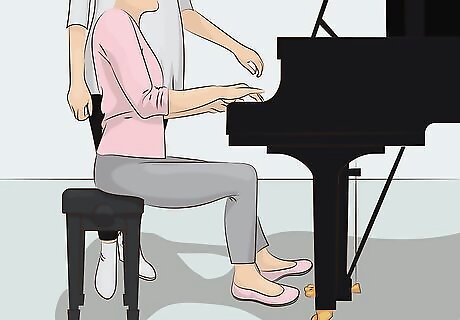
Hire a piano teacher for more focused instruction. Working with a teacher will enable you to make faster progress. An experienced piano teacher will notice little problems and correct them before they become ingrained. Piano teachers also help encourage and motivate you to succeed. It's a good idea to interview several piano teachers before you settle on one, especially if you're looking at private lessons. You'll be spending a lot of time with this person, so you want to make sure you like them. Some piano teachers specialize in particular methods of instruction, while others focus on teaching particular types of students. For example, teachers use different techniques with adult students than with children. Additionally, there are some teachers who are focused on training students who want to become concert pianists, while there are others who are willing to teach less serious students.
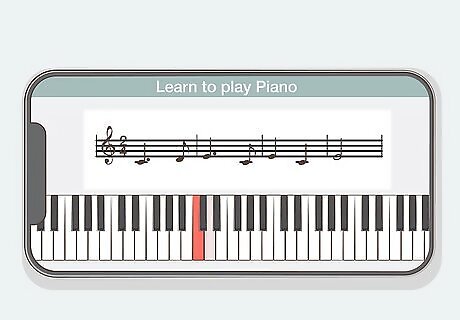
Try a piano app if your learning is self-directed. There are a number of apps that you can download on your smartphone or tablet that will teach you how to play the piano. Some of these apps are more structured than others, so you may want to try out more than one to decide which one you like the best. Most piano apps are free to download. However, your usage may be limited unless you buy a subscription. For example, the app Yousician limits you to 20 minutes a day unless you upgrade to premium. Some apps, such as Mussila Music School, are geared more towards younger children.
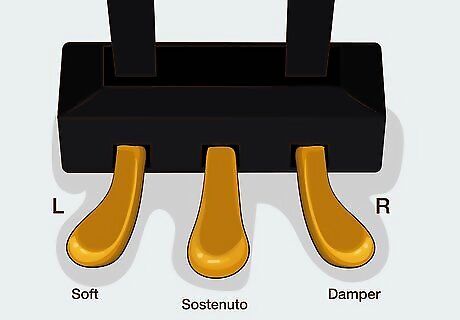
Add use of the pedals if you have an acoustic piano. There are 3 pedals on the piano. From right to left, they are the damper pedal, the sostenuto pedal, and the soft pedal. To use the pedals, press down on the end of the pedal with the ball of your foot, keeping your heel on the floor. The damper pedal is played with your right foot and produces a fuller resonance than you could produce without the pedal. When the pedal is lifted, the notes you play will have a flatter sound. The soft pedal is played with your left foot and creates a muted and less vibrant sound when depressed. The sostenuto pedal in the middle is used to sustain selected notes, particularly lower bass notes, to create a drone as you play. The note held by the sostenuto pedal will be held until the sostenuto pedal is released. You can also use the damper pedal or soft pedal without affecting the note held by the sostenuto pedal.Tip: If you have an electronic keyboard, you can buy pedals as accessories and connect them to your keyboard. However, most electronic keyboards have knobs or buttons that you can adjust for the same effect.














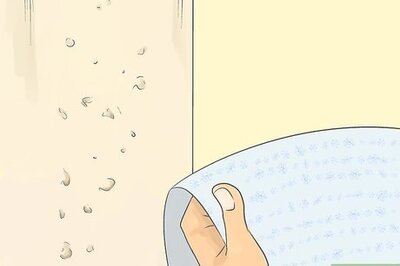



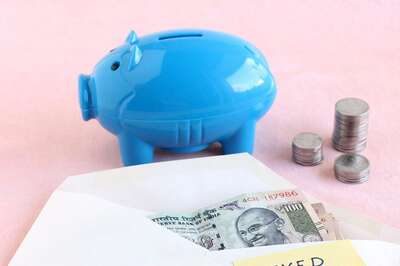

Comments
0 comment